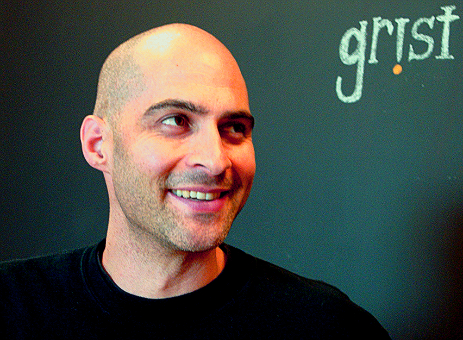 Dr. Kerry Kriger cracks a smile during his visit to Grist’s Seattle HQ.Russ Walker / GristOn Tuesday, the staff at Grist devoured frogs for lunch. Well, not exactly.
Dr. Kerry Kriger cracks a smile during his visit to Grist’s Seattle HQ.Russ Walker / GristOn Tuesday, the staff at Grist devoured frogs for lunch. Well, not exactly.
We sat down with conservation biologist Dr. Kerry Kriger of the newly minted nonprofit Save the Frogs! — one of several stops he’s making in Seattle during a country-wide speaking tour. As one of the lone voices raising the alarm for amphibians, Kriger dished about the worst disease ever to hit wildlife, why it’s such a big deal that one-third of amphibians are threatened with extinction, and just how many people actually are having frogs for lunch.
A scientist by training, Kriger first became involved with amphibians while in Australia researching how frogs are affected by the fungal disease chytridiomycosis, which currently is decimating frog populations and which may be the worst disease ever recorded to hit a group of organisms. It’s the chytrid fungus, and it has caused more than 100 extinctions since the 1970s.
Didn’t know frogs were in such shoddy shape? Don’t worry, you’re the norm. Which is precisely the reason Kriger started Save the Frogs! in the first place. He realized he was writing scientific papers about how bad the situation is globally for frogs, which then got published in journals “normal people don’t read.” On top of all that, he and other scientists were making recommendations based on that research, but there was no one to carry them out. Kriger figured starting a nonprofit was the best way to fill that void.
 His current vision for the organization is simple but powerful: “that everyone in America know that frogs are disappearing.” Once general awareness is established, especially among the younger generation, it is Kriger’s hope that grassroots and legal action to protect frogs and their habitat will follow.
His current vision for the organization is simple but powerful: “that everyone in America know that frogs are disappearing.” Once general awareness is established, especially among the younger generation, it is Kriger’s hope that grassroots and legal action to protect frogs and their habitat will follow.
When asked why the average citizen should care about some dying frogs on a mountain somewhere, Kriger took a minute to measure his answer.
“Frogs have been around 250 million years,” he said. “They’ve outlived the dinosaurs … But in the last 30, 40, 50 years, they’re now going extinct.”
Because thin-skinned frogs live both on land and in the water, they are biological indicators of the planet’s health — the proverbial canaries in the coal mine. With over one-third of these species in imminent danger of extinction, what’s really alarming is that most of us have no idea what’s going on.
If that’s not cause for concern, he reasoned, you only have to look as far as human disease and medicine. Little-known fact: 10 percent of Nobel prizes in medicine and physiology recognized research that was performed, in part, by researchers using frogs. Additionally, frogs eat disease-carrying ticks and mosquitoes, reducing the spread of malaria, dengue fever, and other less-than-desirable conditions people don’t want to catch.
So where is the ray of sunshine in all of this? Kriger admitted he was rarely asked that question, saying, “Good news comes out occasionally.”
However, he went on, individuals can do a lot to reverse the threats to amphibians. A few ways to do this are by supporting organics (keeping harmful pesticides far from frogs), by buying pet or food frogs that are captive-bred and local (America is the second-largest importer of frog legs … who knew?), and by dropping into casual conversation news of the amphibian extinction crisis (over cocktails, naturally).
If you’re interested in hearing more from Kriger, take a look at his list of speaking engagements or contact him to help organize an event in your area. And really, consider skipping the frog legs next time.



